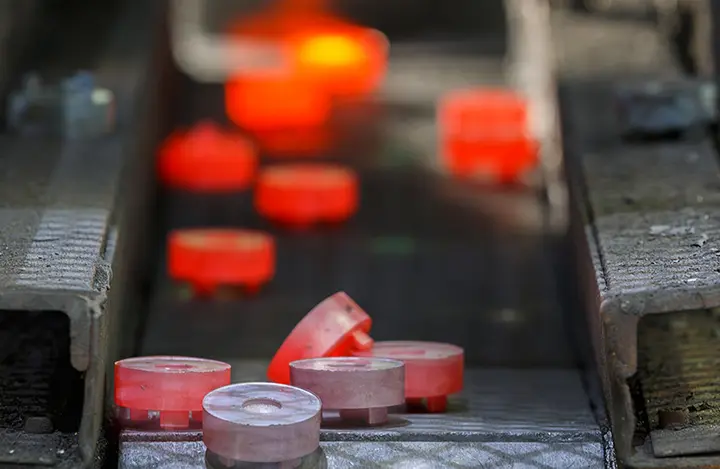
Knowledge
The Influence of Heat Treatment Methods on the Recrystallization Process

Heat treatment methods have a direct and significant impact on the recrystallization process of metallic materials. Recrystallization is an important process in which metallic materials, during heat treatment, eliminate dislocations and crystal defects generated during cold or hot working through the re-nucleation and growth of grains, thereby restoring the material's plasticity and toughness. The following are several common heat treatment methods and their specific effects on the recrystallization process of metallic materials:
Annealing is one of the most common methods in the heat treatment of metal materials. By heating the metal material above its critical temperature and maintaining it at an appropriate temperature for a certain period of time, recrystallization is eventually achieved. The temperature and time during the annealing process are two key factors that affect the recrystallization effect.
In terms of temperature, the selection of annealing temperature is of vital importance. A temperature that is too low will keep the grains in a supersaturated state for a long time, resulting in a slow recrystallization rate and insufficient grain growth; while a temperature that is too high may cause the grains to grow rapidly, and even lead to overheating, which affects the mechanical properties of the material. Therefore, choosing an appropriate annealing temperature can not only effectively promote the recrystallization process but also ensure the optimization of the material's microstructure and properties.
In terms of time, the duration of annealing also has a significant impact on the recrystallization effect. If the time is too short, the grain boundaries of the crystals are not fully formed, the recrystallization process is incomplete, and the internal stress of the material is not effectively eliminated; while if the time is too long, the grains may grow excessively, leading to a decrease in the strength and hardness of the material. Therefore, it is crucial to reasonably control the annealing time so that it can fully complete the recrystallization process without causing excessive grain growth, in order to obtain the ideal recrystallization structure and properties.
Deformation heat treatment is a process that involves subjecting metal materials to plastic deformation to generate a large number of crystal defects, followed by heating treatment to promote recrystallization. Deformation heat treatment mainly includes two methods: cold working and hot working.
Cold working is the plastic deformation of metallic materials at room temperature or lower temperatures, introducing a large number of dislocations and crystal defects, providing necessary conditions for recrystallization. Subsequently, through appropriate heat treatment, these dislocations and crystal defects can be eliminated, promoting the progress of recrystallization and thereby improving the mechanical properties of the material.
Hot working involves deforming metal materials at high temperatures. Due to the better plasticity of materials at high temperatures, hot working can generate more dislocations and crystal defects, providing more favorable conditions for recrystallization. The heat treatment after high-temperature deformation can further promote the recrystallization process and optimize the microstructure and properties of the material.
Quenching and tempering heat treatment are often used to adjust the hardness and toughness of metallic materials. The quenching process rapidly cools the metal material to quickly form a martensitic structure, which has high hardness and strength but also inhibits the progress of recrystallization. Therefore, quenching has a certain inhibitory effect on the recrystallization process. Tempering is an additional heat treatment process after quenching. Through tempering, recrystallization in the metal material can be promoted, residual stress can be reduced, and the toughness and strength of the material can be improved. The selection of tempering temperature and time has an important impact on the recrystallization effect. Reasonable tempering parameters can enable the material to maintain high hardness while achieving good toughness.
Stress heat treatment is a method that promotes recrystallization by applying external stress. Before heat treating metallic materials, applying a certain stress can change the grain boundary energy and dislocation density of the material, thereby influencing the recrystallization behavior. Stress heat treatment not only accelerates the recrystallization process but also can control the morphology and distribution of recrystallized grains by regulating the direction and magnitude of the stress, further optimizing the microstructure and properties of the material.
In conclusion, different heat treatment methods have distinct influences on the recrystallization process of metallic materials. Understanding the principles and characteristics of various heat treatment methods and selecting appropriate processing parameters can effectively control the recrystallization process, achieving the desired microstructure and properties. By rationally applying heat treatment methods, the recrystallization process of metallic materials can be optimized, thereby enhancing their overall performance and meeting various practical application requirements. This not only holds significant importance for the research of materials science but also provides a theoretical basis and practical guidance for optimizing material properties in industrial production.
Vigor team have rich experience onhot working production processes. If any question or any demands we can help, please feel free to contact us atinfo@castings-forging.com



